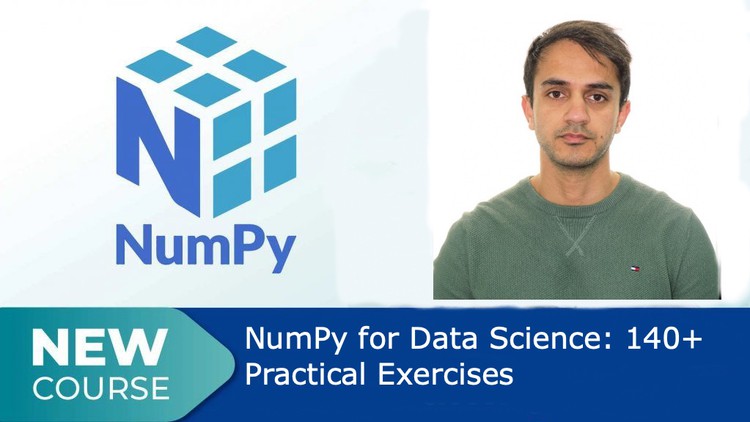NumPy for Data Science: 140+ Practical Exercises in Python

Why take this course?
🌟 Course Title: NumPy for Data Science: Master Data Manipulation with 140+ Practical Exercises in Python 🌟
Course Headline:
Dive into the World of Efficient Data Handling with NumPy!
Course Description:
Embark on a journey to master the NumPy library, an essential tool for any data scientist or Python developer. NumPy for Data Science is meticulously crafted to provide you with a hands-on experience that will solidify your understanding of NumPy's functionalities and applications in data manipulation and analysis. With over 140+ practical exercises, this course is designed to cater to learners at all levels – from beginners to seasoned experts. 📊
What You'll Learn:
-
Array Routine Creation: Master functions like
arange,zeros,ones,eye,linspace,full,intersect1d, andtri. -
Array Manipulation: Gain proficiency in array manipulation techniques such as
reshape,expand_dims,broadcast,ravel,copy_to,shape,flatten,transpose,concatenate,split,delete,append,resize,unique,isnan,trim_zeros,squeeze,asarray,split, andcolumn_stack. -
Logic Functions: Understand and apply logic functions including
all,any,isnan, andequal. -
Random Sampling: Learn to perform random sampling with functions like
random.rand,random.shuffle,random.exponential, andrandom.triangular. -
Input and Output: Get adept at loading data with
loadandloadtxt, and saving data withsave, as well as converting arrays to strings witharray_str. -
Sort, Searching, and Counting: Master sorting techniques, find the indices of elements with
argsort, partition data, locate maxima/minima withargmax/argmin, determine where elements are located withnonzero,where,extract, and count occurrences withcount_nonzero. -
Mathematical Operations: Perform mathematical operations such as
mod,mean,std,median, percentiles, averages, variances, correlations, histograms, divisions, multiplications, powers, and more. -
Linear Algebra: Utilize NumPy's linear algebra capabilities with functions like
linalg.norm,dot,linalg.det, andlinalg.inv. -
String Operations: Manipulate strings within arrays using
char.add,char.split,char.multiply,char.capitalize,char.lower,char.swapcase,char.upper,char.find,char.join,char.replace,char.isnumeric, andchar.count.
Why Take This Course? 🚀
- Versatility: Ideal for data scientists, data analysts, and developers with varying levels of experience in Python and NumPy.
- Comprehensive Curriculum: Offers a broad range of practical exercises to ensure a deep understanding of NumPy's capabilities.
- Skill Enhancement: Whether you're starting out or looking to refine your skills, this course will help you become more efficient and effective in handling data with Python.
- Real-World Application: Learn through exercises that mirror real-world scenarios and challenges faced by professionals in the field of data science.
Enroll now and start your journey to becoming a NumPy expert! 🎓 With this course, you'll not only learn the theoretical aspects of NumPy but also apply them through engaging and practical exercises that will prepare you for real-world data analysis tasks. Don't miss out on the opportunity to elevate your data science skills with Python's most powerful library for numerical computing. 🛠️✨
Loading charts...